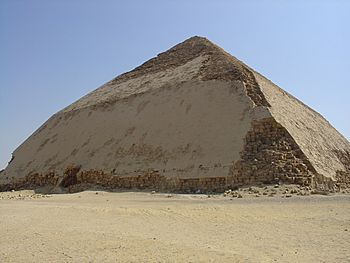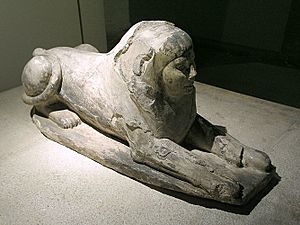Fourth Dynasty of Egypt facts for kids
Quick facts for kids
Fourth Dynasty of Egypt
|
|||||||||
|---|---|---|---|---|---|---|---|---|---|
| ca. 2613 BC–ca. 2494 BC | |||||||||

Sneferu's bent pyramid at Dahshur, an early experiment in true pyramid building
|
|||||||||
| Capital | Memphis | ||||||||
| Common languages | Egyptian language | ||||||||
| Religion | Ancient Egyptian religion | ||||||||
| Government | Absolute monarchy | ||||||||
| Historical era | Bronze Age | ||||||||
|
• Established
|
ca. 2613 BC | ||||||||
|
• Disestablished
|
ca. 2494 BC | ||||||||
|
|||||||||
The Fourth Dynasty of ancient Egypt (also called Dynasty IV) was a "golden age" for the Old Kingdom of Egypt. This period lasted from about 2613 BC to 2494 BC. It was a time of peace and wealth. Egypt also traded a lot with other countries during this time.
The Fourth Dynasty was when pyramid building reached its peak. The peace from the Third Dynasty allowed rulers to focus on art and culture. King Sneferu tried new building methods. These led to the change from mastaba-style step pyramids to smooth-sided "true" pyramids. The famous pyramids on the Giza Plateau are examples of these. No other time in Egypt's history saw such amazing buildings. Almost every ruler of this dynasty built at least one pyramid. These pyramids served as a tomb (burial place) or a cenotaph (a monument for someone buried elsewhere).
The Fourth Dynasty was the second of four dynasties that made up the "Old Kingdom." King Sneferu, the first king, ruled a large area. It stretched from ancient Libya in the west to the Sinai Peninsula in the east. It also went south into Nubia. This was a successful time for Egypt. It is known for its progress and strong government. This can be seen in the organized way the pyramids and other monuments were built.
Most of what we know about the Old Kingdom comes from these large structures. We also learn from objects found in the desert cemeteries of Giza.
Contents
Rulers of the Fourth Dynasty
| King's Name | Horus (Throne) Name | Dates of Rule | Main Pyramid | Wives | |
|---|---|---|---|---|---|
| Sneferu | Nebma'at |  |
2613–2589 BC | Red Pyramid Bent Pyramid Pyramid at Meidum |
Hetepheres I |
| Khufu "Cheops" |
Medjedu |  |
2589–2566 BC | Great Pyramid of Giza | Meritites I Henutsen |
| Djedefre | Kheper |  |
2566–2558 BC ? | Pyramid of Djedefre | Hetepheres II Khentetka |
| Khafre | Userib | 2558–2532 BC | Pyramid of Khafre | Meresankh III Khamerernebty I Hekenuhedjet Persenet |
|
| Menkaure | Kakhet |  |
2532–2503 BC ? | Pyramid of Menkaure | Khamerernebty II |
| Shepseskaf | Shepsesket |  |
2518–2510 BC ? | Mastabat al-Fir'aun | Bunefer |
Key Rulers and Their Achievements
Sneferu: The Pyramid Builder
Sneferu was the first pharaoh of the Fourth Dynasty. He was known as "Bringer of Beauty" and "Master of All Justice." He likely became king by marrying a royal princess. Before Sneferu, Egyptian kings were seen as living versions of the god Horus. They became fully divine only after death. Sneferu was the first to say he was a living form of Ra, the sun god. His son, Khufu, followed this idea.
Sneferu tried to build a perfect pyramid with the Bent Pyramid. But it changed its angle partway up, making it look "bent." His Red Pyramid is seen as the first true pyramid. It got its name from the reddish stone used. This pyramid was built with a strong foundation. This made it stable enough for a very tall building. Sneferu built three pyramids in total, and some records suggest a fourth. He moved more stone and brick than any other king.
Sneferu also led trips to other countries. He went to Nubia and Libya to get workers and building materials. These trips brought back many prisoners and cattle. This helped him build his massive pyramids.
Khufu: Builder of the Great Pyramid

Khufu, known as Cheops to the Greeks, was Sneferu's successor. He is a very famous king even today. He appears in movies, books, and TV shows. His fame comes from his huge pyramid at Giza, where he was buried. This pyramid is known as the Great Pyramid of Giza.
Not much is known about Khufu's other activities. The ancient Greeks believed he was a harsh ruler. They thought he forced his people into slavery. However, there is little proof of this. We know he built a harbor on the Red Sea coast. This was found by explorers in 1823.
Djedefre: A King of Mystery

Historians believe Djedefre ruled for about eight years. His family background is not fully clear. He might have been Khufu's son or brother. Djedefre chose to build his pyramid several kilometers north of Giza. Some think this was due to a family disagreement. Others believe he wanted to be closer to Iunu. This city was a major center for the worship of the sun god Ra. His pyramid also had a statue of his wife, Hetepheres II, shaped like a sphinx. She was Khufu's daughter and lived longer than most royals of this dynasty.
Khafre: The Sphinx's King
Khafre, Khufu's son, became king after Djedefre's short rule. He built his pyramid near his father's. It was similar in style and almost as big. In front of his pyramid's walkway is the famous Great Sphinx. Many believe it has Khafre's face. There is still debate about whether his Sphinx was built before Djedefre's.
Menkaure: The Smallest Pyramid
The length of Menkaure's rule is not certain. He followed his father, King Khafre. His pyramid is the third and smallest at the Giza pyramid complex. It was called Netjer-er-Menkaure, meaning "Menkaure is Divine." A large stone coffin (sarcophagus) was found inside. Like many earlier pyramids, Menkaure's pyramid had no writings or carvings inside.
Shepseskaf: Breaking Tradition
Shepseskaf is generally thought to be the last king of the Fourth Dynasty. He followed Menkaure. We don't know for sure who his mother or wife was. Shepseskaf broke the tradition of building triangular pyramids. Instead, he built a rectangular block structure. It is known as the Mastabat al-Fir’aun ("Pharaoh's Bench"). Like other tombs of this time, it had little writing inside.
Other Important People
Khentkaus I: A Possible Queen-King?
Khentkaus I was a very interesting person from the Fourth Dynasty. She was a daughter of Menkaure. Her tomb was built near Menkaure's pyramid. Some historians believe she might have ruled as a king herself.
Her tomb is a large mastaba (a flat-topped tomb). On a granite doorway to her tomb, her titles are written. They could mean "mother of two kings" or "king of Upper and Lower Egypt and mother of two kings." Also, pictures on this doorway show her with the full symbols of a king. This includes the false beard worn by pharaohs. Because of this, some experts think she ruled as a king near the end of the Fourth Dynasty.
The Age of the Pyramids
The "Age of the Pyramids" refers to the Fourth Dynasty. This was the time when most of the famous pyramids, like those at Giza, were built. King Sneferu was the first king to show great interest in burial practices and tombs. This led him to plan Egypt's largest pyramids. His first pyramids were the Bent Pyramid and Red Pyramid.
The "Age of the Pyramids" was not just about building huge structures. It also brought changes in how people were buried and in religious rituals. This included burying important people in large tombs. It also saw the widespread use of mummification.
Religious Changes
The Fourth Dynasty saw a big change in religious practices. Worship of the Sun god Ra became very common. The Cult of Ra grew larger. Djedefre's tomb was built closer to the main center of Ra worship. This city was called Heliopolis by the Greeks. Its ancient Egyptian name was Iunu, meaning "the pillars."
During this time, kings became very powerful. They started to carve their names on statues and monuments. These had previously been only for gods. Kings also began to connect themselves more closely with the gods. For example, Khafre's famous statue shows a falcon on his headgear. This linked the king to the god Horus.
Kings also changed their ideas about the afterlife. It was once thought to be a divine kingdom, like a perfect heaven. Only kings and pure souls could go there. But in the Fourth Dynasty, the idea changed. The afterlife was seen as a familiar place, similar to Earth.
How Customs Changed Building Styles
The Old Kingdom saw a rise in preserving the dead. Preparing bodies became much more complex. A new job, "embalmer," was created. Their only job was to prepare bodies in private. There were three main ways to mummify a body:
- Stucco: The body was wrapped in fine linen. Then it was covered in stucco plaster. The body's features, including the face, were shaped in the plaster.
- Linen: The body was wrapped in linen. Sometimes this linen was treated with natron (a mix of sodium carbonates). Resin was also used on the linens to shape the body's features.
- Defleshing: All flesh was removed. The bones were then wrapped in linens.
Generally, organs were removed and placed into special jars. These jars would then go into the tomb with the body.
Tombs in the Fourth Dynasty changed a lot. Important people wanted more impressive graves. They might accept smaller structures if the inside was decorated. Hieroglyphic writings were important to these elites. They showed wealth and were believed to guide souls to the afterlife. However, Fourth Dynasty tombs did not have these writings inside. Instead, the burial chamber was deeper, and the structures above ground were larger. After the Giza pyramid complex, later tombs were more normal in size. After the Middle Kingdom, royals stopped building pyramids. They preferred tombs carved into the rock of the Upper Egyptian mountains.
Timeline
Fourth Dynasty timeline

See also
 In Spanish: Dinastía IV de Egipto para niños
In Spanish: Dinastía IV de Egipto para niños





